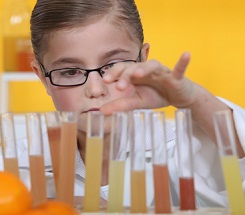We’re all born with a curiosity about the world around us that makes us natural scientists. Some of the earliest words we learn are for identifying things and people that are familiar to us and for asking questions about everything else. It’s how we learn to make sense of the world around us so we can make predictions and adjust our responses. I’ll bet you can still recall the squishy feel of an earthworm, or the feel of a dead leaf crumbling in your hand, but can you remember any of the questions on your college entrance exams? Somewhere along the way we lose that sense of wonder, as teaching science turns into drilling students about the details of what we already know instead of the process of discovery itself. Rather than getting bogged down in the what, we should focus on the why and the how. To teach science effectively, try framing the approach differently; science is not a subject to be taught, but rather a process we use for learning something new.
Scientific inquiry is a built-in skill that can readily be honed in a classroom with the right approach. The key to making lessons engaging is to take advantage of kids’ natural curiosity about the world and their desire to explore it. Touch, prod, poke, squish, pour, spill, fill, re-fill, peer, peek, sort, and count are the things our kids do when we leave them to their own devices to play. The goal is to take the curriculum you’re required to teach your students and make it come alive for them by letting them do what comes naturally. Science is particularly well suited for hands-on lessons. Let’s take the example of teaching the Water Cycle. You can give your students a simple, hands-on experience that really brings home these important concepts about how earth’s water is continually recycled through the changing states of matter. Set up a demonstration of the three states of water and let your students touch!
Liquid Water – display three samples of water in clear containers; one room temperature, one chilled, and one hot. Use some inexpensive food coloring and have the students add a drop of color to each of the three samples of water without stirring. Have them record their observations about how slowly, or quickly, the color is dispersed in the different water temperatures. This is a great time to explain about convection currents and how water molecules move even when you don’t stir them.
Water Vapor (gas) – use a vaporizer, or if you have a boiler plate and a saucepan/tea kettle, boil some water. If you have heated tap water in or near your classroom, that may also suffice (if the weather is cool enough). Many young kids have trouble with the idea that when water evaporates, it doesn’t just vanish — it turns into gas form and goes into the air. Give them some paper and have them hold it over the escaping steam and record what happens. Have them explain why the paper is wet. If they can get the paper wet enough with steam, then have them try to wring the water out of the paper to recover the liquid water. You can also give them a mirror and have them exhale onto it to see the water vapor in their own breath.
Solid (ice) – set ice cubes out on trays and provide clear containers of water. Have students note and record the properties of water in solid form. Let them put ice into the water and watch the ice melting into the surrounding water. Better yet, freeze water with food coloring in it and have them watch the ice melting into clear containers of water. If you have time, then let the students experiment with making ice melt; does it melt faster in room temperature, cold, or heated water, does it melt faster if you break the cubes into smaller pieces or crush it? Have students explain why there’s water on the outside of the beaker of cold water/ice.
The observations your students make in this simple classroom activity are likely to be familiar to them already. But having them look carefully at the changing states of matter through the lens of scientific inquiry does two things; 1) focuses on the discipline of observation, measuring, and recording and 2) cements the basic concepts you are teaching in tangible and unforgettable ways (they won’t soon forget the awesomeness of watching a colored ice cube melt into the surrounding water). The most important lesson we teach our kids is that science is a process of asking and answering questions about what we can observe and measure. Exploring something interactively makes it come alive and engages students in ways that cements discoveries into lifelong lessons.
